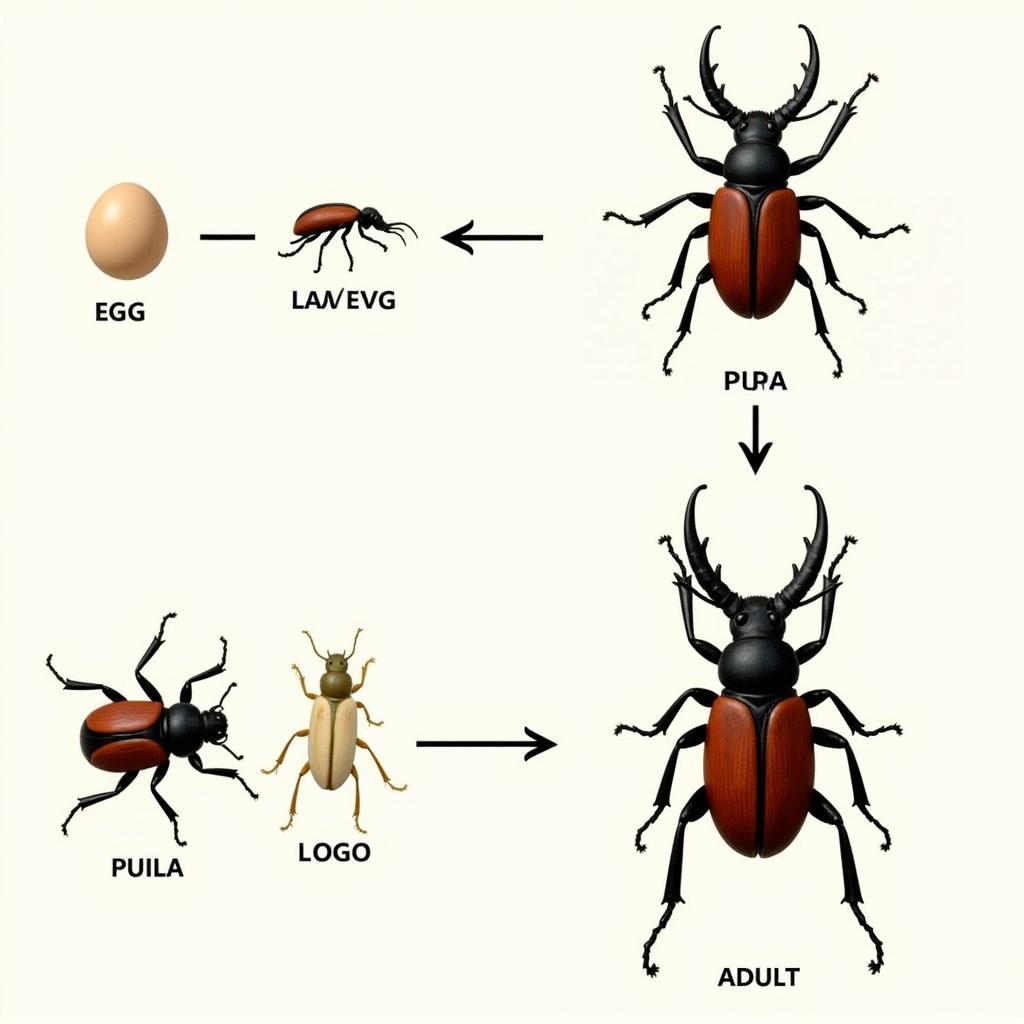Unveiling the African Goliath Beetle: A Giant Among Insects
The African Goliath beetle, an impressive creature of the Scarabaeidae family, reigns as one of the largest insects on Earth. These colossal beetles are native to the tropical forests of Africa and captivate with their sheer size and unique life cycle. Let’s delve into the fascinating world of these gentle giants.
African Goliath Beetle: Size, Appearance, and Habitat
African Goliath beetles are truly giants among insects. Males can reach lengths of up to 4.3 inches (110 mm) and weigh up to 3.5 ounces (100 grams) in their larval stage, though they are slightly smaller as adults. Their exoskeletons boast a striking combination of black, brown, and white markings, providing excellent camouflage in their forest habitat. These markings vary depending on the subspecies. They primarily inhabit the tropical and subtropical rainforests of Africa, where they play a vital role in the ecosystem.
The Life Cycle of the African Goliath Beetle
The African Goliath beetle undergoes a complete metamorphosis, progressing through four distinct stages: egg, larva, pupa, and adult. Females lay their eggs in decaying wood and other organic matter, providing a readily available food source for the developing larvae. The larval stage, or grub stage, is the longest, lasting several months and sometimes up to a year. During this time, the larva grows to an enormous size, consuming vast amounts of decaying matter. The pupa stage is a period of transformation, where the larva develops into its adult form. Finally, the adult beetle emerges, ready to reproduce and continue the cycle.
 African Goliath Beetle Life Cycle Stages
African Goliath Beetle Life Cycle Stages
What Does the African Goliath Beetle Eat?
The diet of the African Goliath beetle varies throughout its life cycle. As larvae, they are primarily detritivores, meaning they feed on decaying organic matter, including wood, leaves, and fruit. This feeding behavior contributes to nutrient recycling within their ecosystem. As adults, their diet shifts to include tree sap, fruits, and nectar. They are particularly fond of sweet substances.
Are African Goliath Beetles Dangerous?
Despite their intimidating size, African Goliath beetles are not dangerous to humans. They are gentle giants, equipped with strong claws for gripping but lacking any venomous bite or sting. While males possess a Y-shaped horn used in territorial battles with other males, they are generally not aggressive towards humans.
Keeping African Goliath Beetles as Pets
African Goliath beetles are increasingly popular as pets due to their impressive size and relatively low maintenance. They require a spacious enclosure with a substrate of coconut fiber or peat moss, maintained at a high humidity level. Their diet in captivity consists primarily of beetle jelly and fruits. It’s important to note that while they are fascinating creatures to observe, handling should be minimized to avoid stressing the beetle.
Conclusion: The Majestic African Goliath Beetle
The African Goliath beetle is a truly remarkable insect, deserving of its title as one of the world’s largest. From its impressive size and striking appearance to its fascinating life cycle and gentle nature, the African Goliath beetle continues to capture the imagination of entomologists and nature enthusiasts alike. Learning about these giants provides a deeper understanding of the biodiversity within the African rainforests.
FAQ
- What is the lifespan of an African Goliath beetle? The lifespan of an adult African Goliath beetle is relatively short, typically only a few months.
- Where can I find African Goliath beetles? They are native to the tropical and subtropical rainforests of Africa.
- Are African Goliath beetles good pets? Yes, they can make interesting pets for those willing to provide the necessary care and environment.
- Can African Goliath beetles fly? Yes, they are capable of flight despite their size.
- What is the role of the male’s horn? The horn is primarily used in territorial disputes with other males.
- What do African Goliath beetle larvae eat? They primarily eat decaying organic matter, such as wood and leaves.
- How big do African Goliath beetle larvae get? They can grow up to 4.3 inches long and weigh up to 3.5 ounces.
Common Scenarios and Questions
- Can I breed African Goliath beetles in captivity? Yes, it is possible, but requires specific conditions and careful monitoring.
- What are the signs of a healthy African Goliath beetle? A healthy beetle will be active, have a good appetite, and exhibit bright coloration.
- My African Goliath beetle is not moving, what should I do? Check the temperature and humidity levels of the enclosure and consult a veterinarian specializing in exotic pets.
Further Exploration on African Life
Explore other fascinating articles on our website about the diverse wildlife and cultures of Africa, including the dung beetle, another fascinating insect, and the rich traditions of the Maasai people.
Need Help? Contact Us!
For further assistance or inquiries regarding African Goliath Beetles or any other aspects of African Life, feel free to reach out to us. You can contact us via phone at +255768904061, email at [email protected], or visit us at Mbarali DC Mawindi, Kangaga, Tanzania. We have a dedicated customer service team available 24/7 to assist you.



